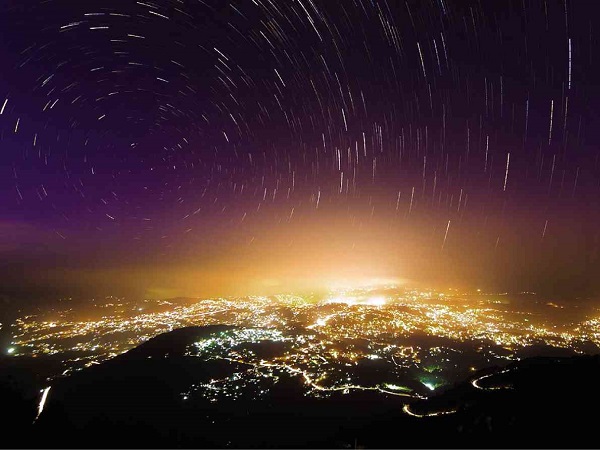Delight to October nights of celestial spectacles

STARRY NIGHT IN BAGUIO The country’s summer capital turns into a city of lights on the ground and in the sky, as this long-exposure shot turns bright stars into streaks of light against a purple canvas, a scene worthy of a Van Gogh painting. October is a month of celestial spectacles for stargazers. RICHARD BALONGLONG/INQUIRER NORTHERN LUZON
MANILA, Philippines—October nights will offer a number of celestial spectacles for stargazers, including the Square of Pegasus signaling the arrival of the northern fall and the Orionids meteor shower in the middle of the month.
“The Square of Pegasus takes center stage in the Philippine night sky after sunset, which is a sign of the arrival of the northern fall. Northeast of it lies the Andromeda Galaxy (M31), the closest large spiral galaxy to the Milky Way Galaxy,” according to the monthly astronomical diary of the astronomical section of the Philippine Atmospheric, Geophysical and Astronomical Services Administration (Pagasa).
“Under clear skies and with the aid of a star map and familiarity with the surrounding background stars, it can be seen as an elongated misty patch with the naked eye and can be easily viewed through binoculars and telescopes,” the diary prepared by Pagasa officer in charge Vicente Malano said.
Cassie and the Dogs
 Furthermore, astronomy enthusiasts will be able to see the splendid W formation of stars known as the constellation of Cassiopeia, named after the wife of King Cepheus and the mother of Andromeda in Greek mythology. Cassiopeia lies to the left of the Square of Pegasus.
Furthermore, astronomy enthusiasts will be able to see the splendid W formation of stars known as the constellation of Cassiopeia, named after the wife of King Cepheus and the mother of Andromeda in Greek mythology. Cassiopeia lies to the left of the Square of Pegasus.
The constellation of Pisces, the Fish, will be found at Cassiopeia’s lower right, Pagasa said.
The famous equilateral triangle in the sky known as the Winter Triangle rises after midnight, it said.
The Triangle is composed of Betelgeuse, the supergiant red star and the prominent star of the famous constellation Orion (the Mighty Hunter); Sirius, the brightest star in the constellation Canis Major (the Big Dog), and Procyon, the brightest star in the constellation Canis Minor (the Little Dog).
Meteor shower
On Oct. 17-25, the Orionids meteor shower will be active, producing up to 15 meteors per hour that may be observed in favorable sky conditions, Pagasa said.
“But sometimes there are lulls even during the traditional maximum peak nights of Oct. 21-22, it said.
“Unfortunately, a waning bright moon in the sky during the morning hours will wash out fainter meteors and diminish the [visibility] of brighter meteors. The radiant of the shower, will be observed north of Betelgeuse, the brightest star in the constellation Orion,” Pagasa said.
Planetary shows
On Oct. 7, two hours before sunrise, Jupiter will be shining luminously at magnitude -1.80 while Mars will glow at magnitude +1.6. Both planets will be observable during early morning hours throughout October, Pagasa said.
On the same date, after sunset, Venus, Saturn, Mercury and a very thin crescent moon will be a great target for observation and astrophotography if the sky is cloudless, it said.














